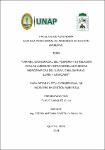Variabilidad espacial del fósforo y su relación con las avenidas y estiajes de las cuencas hidrográficas del Nanay, Chillón-Rímac-Lurín y Azángaro
Abstract
The present investigation was carried out to estimate the degree of vulnerability to eutrophication by phosphorus in surface waters of the basins of the Rímac, Lurín and Chillón rivers of the Pacific basin, Nanay river of the Atlantic basin and the Azángaro river of the Titicaca basin. The data was collected from the National Water Resources Information System (SNIRH), the National Water Authority (ANA) and the National Meteorology and Hydrology Service (SENAMHI). The Kruskall-Wallis non-parametric test and a Post Hoc analysis between pairs, with Bonferroni adjustment, were used to determine which of the sample groups are significant in terms of vulnerability. For the prediction analyzes of the time series of the variations of the total phosphorus concentration in the basins, the Holt-Winters mathematical model with exponential smoothing was used.
It was found, according to the Holt Winter prediction analysis, that for the dry season in Nanay, slight increases in total phosphorus concentration levels are expected, which exceed the LMP and maintain a slight increase for the next few years. While in avenues the concentration levels are below the LMP and with a decreasing trend in the coming years. In the Rímac river, during the dry season and flood, concentration levels are expected to exceed the LMP in the coming years. In the Lurín river, for the dry season and flood, it foresees concentration levels that greatly exceed the LMP in the coming years. In the Chillón river, for dry seasons and floods, concentration levels are expected to exceed the LMP for the coming years, but in flood times the concentration levels have a decreasing trend. On the other hand, in the Azángaro river, the analysis foresees that the concentration levels for the dry season and flood season are similar, do not exceed the LMP and that they have a decreasing trend line for the coming years. There is statistical significance (p<0.05) between the levels of spatial vulnerability to eutrophication (phosphorus concentrations) between the hydrographic basins located on the Pacific, Atlantic and Titicaca slopes, evidencing the significance in the most significant paired basins of Nanay (Atlantic). - Chillón (Pacific), Nanay (Atlantic)-Lurín (Pacific), Azángaro (Titicaca)-Chillón (Pacific) and Azángaro (Titicaca)-Lurín (Pacific), therefore the alternative hypothesis is accepted and the null hypothesis is rejected. La presente investigación se realizó para estimar el grado de vulnerabilidad de eutrofización por fósforo en aguas superficiales de las cuencas de los ríos Rímac, río Lurín y río Chillón de la cuenca del Pacifico, río Nanay de la cuenca del Atlántico y el río Azángaro de la cuenca del Titicaca. Los datos se recolectaron del Sistema Nacional de Información de Recursos Hídricos (SNIRH), Autoridad Nacional del Agua (ANA) y el Servicio Nacional de Meteorología e Hidrología (SENAMHI). Se utilizó la prueba no paramétrica de Kruskall-Wallis y un análisis Post Hoc entre parejas, con ajuste de Bonferroni para determinar cuáles de los grupos de muestras son significativas en cuanto a la vulnerabilidad. Para los análisis de predicción de las series temporales de las variaciones de la concentración de fósforo total en las cuencas, se utilizó el Modelo matemático de Holt-Winters con suavizado exponencial.
Se encontró, según el análisis de predicción de Holt Winter, que para la época de estiaje en el Nanay prevé ligeros incrementos en los niveles de concentración de fósforo total, que superan los LMP y mantienen un ligero incremento para los próximos años. Mientras que en avenidas los niveles de concentración están por debajo de los LMP y con tendencia decreciente en los próximos años. En el río Rímac, en época de estiaje y avenida prevé niveles de concentración que superan los LMP en los próximos años. En el río Lurín para época de estiaje y avenida prevé niveles de concentración que superan largamente los LMP en los próximos años. En el río Chillón para épocas de estiaje y avenida prevé niveles de concentración que superan los LMP para los próximos años, pero en época de avenida los niveles de concentración tienen una tendencia decreciente. Por su lado, en el río Azángaro el análisis prevé que los niveles de concentración para época de estiaje y avenida se muestran similares, no superan los LMP y que tienen una línea de tendencia decreciente para los próximos años. Existe significancia estadística (p<0.05) entre los niveles de vulnerabilidad espacial de eutrofización (concentraciones de fósforo) entre las cuencas hidrográficas localizadas en las vertientes del Pacifico, Atlántico y Titicaca, evidenciándose la significancia en las cuencas emparejadas más significativas de Nanay (Atlántico) - Chillón (Pacifico), Nanay (Atlántico)-Lurín (Pacifico), Azángaro (Titicaca)-Chillón (Pacifico) y Azángaro(Titicaca)-Lurín (Pacifico), por lo que acepta la hipótesis alterna y se rechaza la hipótesis nula.
Collections
- Tesis [501]


